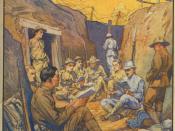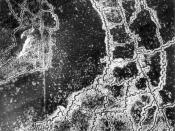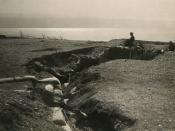The First World War was truly a horrific experience it marked a watershed in the nature of European Warfare. As tensions rose and quickly exploded countries were forced to "dig in", invent or improve armaments, and to seek out an Air Force. Proving to many that this "Great War" definitely would not have a quick ending as at first expected.
The dark and lonely life of trench warfare, used for the first time in WW1, shone a light on what was to become the new European warfare. Very early into the war German troops were ordered to "dig in", in order to stop their retreat and prevent the Allied advance. The Allies soon realized that they could not break through the lines and were also forced to "dig in". After only a few months trenches became the horrible way of life and so extensive that they were said to spread from the North Sea to the Swiss Frontier.
Trenches were usually about 7 feet deep, and 6 feet wide, depending on location and the amount of men occupying them, trenches could reach up to double that size or half that size. The front of the trenches was known as the parapet, it consisted of 2 to 3 feet of sandbags to stop bullets and shell fragments. At the bottom of the parapet would be the Firestep, which enabled troops to see over the edge and prepare for enemy invasions. The distance between the Allied and Enemy trenches was known as "No man's land" for obvious reasons. Soldiers would spend 10 days in the front line followed by 4 days in the reserves, then 2 days out of the trenches. As the war progressed and military numbers decreased, soldiers were forced to endure up to forty-five days in the front line.


